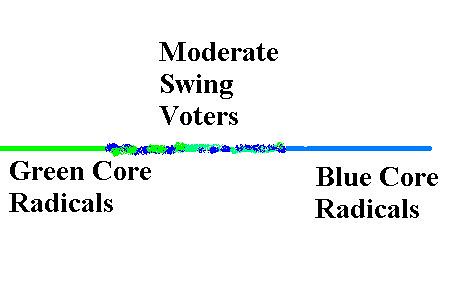Swing Voters in Taiwan Redux
 The Taipei Times offered up several views of the upcoming election cycle from local analysts yesterday. First it argued that parties are moving toward the "center".
The Taipei Times offered up several views of the upcoming election cycle from local analysts yesterday. First it argued that parties are moving toward the "center".The Democratic Progressive Party's (DPP) likely presidential candidate, former premier Frank Hsieh (
謝長廷 ), is known for his moderate stance. He has been advocating the concept of "reconciliation and coexistence" and has said that he would be happy to team up with Chinese Nationalist Party (KMT) presidential candidate Ma Ying-jeou (馬英九 ) against the Chinese Communist Party if elected.In a bid to court voters in the middle of the political spectrum, the KMT is expected to revise its party charter next month and include "Taiwan-centered" values in the revised version. The changes will mark the first ever mention of "Taiwan" in the party's charter.
Ma, who is born to Mainlander parents, has been trying to convince Legislative Speaker Wang Jin-pyng (王金平), a non-Mainlander, to pair up with him in the presidential race.
In some political theories, movement toward the center is known as the principle of minimum differentiation: since there is some amount of public policy X that is best to have, politicians in rational electoral systems will both move toward that, and after a while, will come to look like each other. That is essentially what had happened in the US until the rise of the Right after the late 1970s perturbed the cozy Republicrat political Establishment. That is also what has happened here in Taiwan: across a wide range of issues, there is broad agreement on what the System should look like. If only it weren't for that pesky national identity thing.....
One of the analysts they talked to appeared to have things down pretty well:
Wu Chih-chung (
吳志中 ), a political science professor at Soochow University, said that it was logical for political parties to take a pragmatic approach, but added that he did not think there would be much room for moderate parties.Hsieh may be a moderate and the KMT seems poised to change its party charter, but what the two parties do does not necessarily reflect their intention to move toward the center, Wu said.
Citing the recent wrangling over the name change of the Chiang Kai-shek Memorial Hall as an example, Wu said that the issue was a perfect example of an ideological battle between the pan-blue and pan-green camps.
As the upcoming legislative elections will adopt a new electoral system, Wu said the DPP and KMT would continue to dominate local politics and smaller parties would find it difficult to survive. In order to win votes, the two bigger parties will continue to use ideological issues as their political leverage to consolidate support.
The Chinese factor also plays a significant role, Wu said. The more Beijing suppresses Taiwan, the more the public resists and the more Taiwanese resist, the less room smaller parties have.
Wu said that many people detest the political bickering between the two camps, but when it comes to elections, voters stand by the two main parties.
This is what I have been saying too. Since only national identity issues separate the parties (along with renewable energy and a few other items), voters can only distinguish between the KMT and the DPP on national identity lines, and respond accordingly even if they do make noises now and then about the political bickering.
What of the other analyst? He noted:
Chao Yung-mau (
趙永茂 ), a political science professor at National Taiwan University, said that it was clear that political parties wanted to move toward the center to win votes because they realized moderate voters played a significant role in elections.It is a good sign that political parties want to adjust their course, Chao said, adding that they should map out details of their new policies rather than just touting their changes.
Chao said the KMT's plan to change its party charter was a move made in response to the DPP's efforts to tap into swing voters. It remains to be seen whether the two parties can quell the concerns of their party members while making changes.
This analyst is still working with the mental that there is a "political spectrum" out there that voters move along, and the goal is to capture the undecided "moderate" voters in the middle. That one looks something like:
Under this view, people at the ends are basically unthinking robots who simply act out the political demands of their masters, while those smart moderates in the center can be captured by good public policy offerings. Reality is, of course, opposite -- anyone who lies between Green and Blue in Taiwan isn't a moderate swing voter, but someone totally apathetic about the system and not participating in voting. The fundamental assumption of the "spectrum" view above is that moderates shade into radicals on either end, and that there are a lot more moderates who can be captured by offering good public policy aimed at the center. That assumption used to be paradigmatic for the United States, but it doesn't work very well for Taiwan. In my opinion, Taiwan looks something like this:
Under this view, "swinging" takes place only when a voter shifts political identity from one line to the other. On the left end are the core voters who reliably come out to vote Green or Blue, who are generally labeled "deep". On the right end are voters who are meh about their own identities and stay home if they don't like the candidate, usually labeled "light" in the press. My view here recognizes several realities about Taiwan:
there is no spectrum. The light voters do not blend into each other at the end since these political identities have no overlap; they cancel each other out. Hence, the lines do not touch. there are a lot more Green voters. More Greens are Light Greens. there are fewer Blue voters overall. Relatively fewer Blues are Light Blues. this works only at the national level. For the local level, apply to your local clan and patronage networks. In this view the distinguishing characteristic of Core and Light voters is willingness to vote. The spectrum is not one of identity vs. policy, but of voter apathy. That is why the "middle" contains people who don't vote at all.
This raises the question of why, then, do parties behave as though there is a "center" full of moderates who must be appealed to? Why do they engage in last-minute electoral stunts that appear to assume some voters are undecided, such as Chen Chu's release of a videoing showing alleged vote-buying by her opponent's side the day before the latest Kaohsiung mayoral election, or a similar event in the previous cycle of county chief elections, in which supporters of DPP candidate Su were allegedly captured vote buying?
In my view both sides get out the vote by appealing to their respective bases, not by appealing to undecided centrist voters. But that base consists of human beings who vote for a variety of reasons. While few voters will switch to the Other Side, the Light voters might not come out unless they are given other sweeteners in addition to appeals to political identity -- public policy and of course, stunts that make victims out of one's own side. Chen Chu's release of the vote-buying video was not an appeal to last minute undecided voters who make up their minds based on whether a politician is "corrupt", it was a statement of victimhood that appealed to her own side: See!? I'm getting the shaft! Come out and help! Such moves ask Light voters to come out and Stand By Their Man.
I'm still working on it. But any "spectrum" model used to study Taiwan will fail to grasp Taiwan, in my view. As with so many other areas of human life, the analysis used to understand western industrialized democracies won't really work on The Beautiful Isle.
[Taiwan] [DPP] [KMT] (cross-posted from The View from Taiwan)
Labels: 2008 presidential election, DPP, KMT, media


















0 Comments:
Post a Comment
<< Home